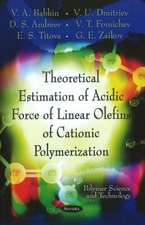Polymer Alloys II: Blends, Blocks, Grafts, and Interpenetrating Networks: Polymer Science and Technology Series, cartea 11
Editat de Daniel Klempneren Limba Engleză Paperback – 25 feb 2012
Din seria Polymer Science and Technology Series
-
 Preț: 402.38 lei
Preț: 402.38 lei -
 Preț: 402.98 lei
Preț: 402.98 lei - 18%
 Preț: 1397.34 lei
Preț: 1397.34 lei -
 Preț: 394.51 lei
Preț: 394.51 lei -
 Preț: 407.19 lei
Preț: 407.19 lei -
 Preț: 403.91 lei
Preț: 403.91 lei - 15%
 Preț: 666.41 lei
Preț: 666.41 lei - 18%
 Preț: 1240.30 lei
Preț: 1240.30 lei -
 Preț: 387.75 lei
Preț: 387.75 lei -
 Preț: 390.25 lei
Preț: 390.25 lei -
 Preț: 403.15 lei
Preț: 403.15 lei -
 Preț: 393.74 lei
Preț: 393.74 lei -
 Preț: 393.74 lei
Preț: 393.74 lei -
 Preț: 390.63 lei
Preț: 390.63 lei - 18%
 Preț: 1855.26 lei
Preț: 1855.26 lei -
 Preț: 399.67 lei
Preț: 399.67 lei -
 Preț: 400.85 lei
Preț: 400.85 lei -
 Preț: 391.40 lei
Preț: 391.40 lei -
 Preț: 402.56 lei
Preț: 402.56 lei -
 Preț: 404.29 lei
Preț: 404.29 lei -
 Preț: 401.42 lei
Preț: 401.42 lei - 18%
 Preț: 959.04 lei
Preț: 959.04 lei - 18%
 Preț: 959.19 lei
Preț: 959.19 lei - 15%
 Preț: 679.47 lei
Preț: 679.47 lei - 18%
 Preț: 1550.92 lei
Preț: 1550.92 lei -
 Preț: 384.70 lei
Preț: 384.70 lei -
 Preț: 385.62 lei
Preț: 385.62 lei -
 Preț: 411.64 lei
Preț: 411.64 lei - 18%
 Preț: 951.47 lei
Preț: 951.47 lei - 15%
 Preț: 637.59 lei
Preț: 637.59 lei -
 Preț: 403.15 lei
Preț: 403.15 lei - 15%
 Preț: 710.56 lei
Preț: 710.56 lei - 15%
 Preț: 656.89 lei
Preț: 656.89 lei - 18%
 Preț: 1238.42 lei
Preț: 1238.42 lei -
 Preț: 384.70 lei
Preț: 384.70 lei -
 Preț: 403.37 lei
Preț: 403.37 lei -
 Preț: 395.85 lei
Preț: 395.85 lei -
 Preț: 388.34 lei
Preț: 388.34 lei -
 Preț: 396.02 lei
Preț: 396.02 lei
Preț: 390.63 lei
Nou
Puncte Express: 586
Preț estimativ în valută:
74.75€ • 78.25$ • 61.85£
74.75€ • 78.25$ • 61.85£
Carte tipărită la comandă
Livrare economică 07-21 aprilie
Preluare comenzi: 021 569.72.76
Specificații
ISBN-13: 9781468436310
ISBN-10: 1468436317
Pagini: 296
Ilustrații: IX, 282 p.
Dimensiuni: 170 x 244 x 16 mm
Greutate: 0.48 kg
Ediția:Softcover reprint of the original 1st ed. 1980
Editura: Springer Us
Colecția Springer
Seria Polymer Science and Technology Series
Locul publicării:New York, NY, United States
ISBN-10: 1468436317
Pagini: 296
Ilustrații: IX, 282 p.
Dimensiuni: 170 x 244 x 16 mm
Greutate: 0.48 kg
Ediția:Softcover reprint of the original 1st ed. 1980
Editura: Springer Us
Colecția Springer
Seria Polymer Science and Technology Series
Locul publicării:New York, NY, United States
Public țintă
ResearchCuprins
Section I. Graft Copolymers.- Morphology and Phase Relationships of Low-Molecular-Weight Polystyrene in Poly (Methyl Methacrylate) and Methyl Methacrylate/ Styrene Copolymers.- Preparation of Highly Branched Graft Copolymers by Chain Transfer Reaction.- Styrene Copolymerization with Rubber. I. Studies of Polystyrene Grafting to Rubber: Molecular Weight Characteristics of Homeo-Polystyrene Matrix.- Styrene Copolymerization with Rubber. II. Relationship between Polymer Morphology and Synthesis Conditions.- Studies of Styrene Copolymerization with Rubber. III. The Process Peculiarities Brought About by the Presence of Aliphatic Mercaptans.- Section II. Block Copolymers.- Techniques of Block Copolymer Preparation.- Preparation of Block Copolymers from Styrene-Acrylonitrile Macroradicals.- Comparison of the Structure-Properties in 2,4 TDI Based Polyether Polyurethanes and Polyurethaneureas.- The Preparation and Photooxidative Degradation of Polyesterurethane-Poly (Methyl Methacrylate) Triblock Copolymers.- Section III. Interpenetrating Polymer Networks.- Interpenetration of Silica in a Network of Cellulose and Divalent Lead to Form Glassy Polymers.- Aspects of Relative Network Continuity and Physical Crosslinks via an Analysis of Polystyrene/Polystyrene Homo-Interpenetrating Polymer Network Literature.- Polyurethane-Acrylic Copolymer Pseudo Interpenetrating Polymer Networks.- Poly(2,6-Dimethyl-l,4-Phenylene Oxide) Polystyrene Interpenetrating Polymer Networks.- Section IV. Polyblends.- Compatibility and Tensile Properties of PPO Blends.- Crystallization from Miscible Polymer Blends.- An Analysis of the Thermal Degradation Under Processing Conditions of ABS/PVC Blends.- Dynamic Viscoelasticity of Wood-Polymer Composites Prepared by an Electron Beam Accelerator.










